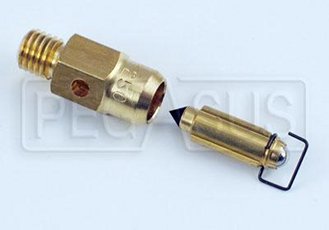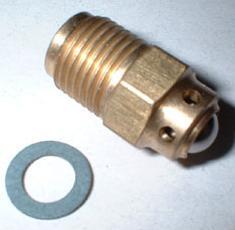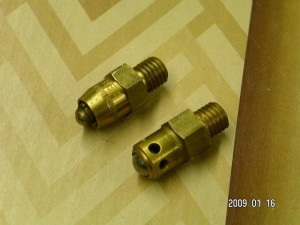Weber Needle & Seat – Grose Jet
By Merak Group
What is and how does the Weber needle and seat [sometimes referred to as the carburetor float valve] compare with the Grose needle and seat [sometimes referred to as the Grose jet valve or Grose jet]?
  |
The Weber seat is basically a hollow brass fitting that is cylindrical in shape. It screws into the underside of the Weber 44 DCNF carburetor top cover. It directly receives the fuel flow from the fuel rail. The needle resides inside the seat. The needle is also a cylindrical solid piece of brass that on one end has a spring-loaded ball bearing and the other end has a conical tip. The needle has three ridges spaced 33 degrees apart to not only center it in the seat, but to also offer the smallest surface area of friction and allow for the greatest flow rate of fuel, these are the sliding surfaces upon which the needle slides up and down on within the seat.
The conical end of the needle controls the rate of fuel flow into the fuel bowl. As the conical end of the needle is pushed further up into the bore of the seat, the area of the fuel inlet/opening is thereby narrowed, decreasing fuel flow. The other end rests against the float tab. The spring-loaded ball, acts as a shock absorber at the contact point of the tab. As the fuel in the bowl fills or decreases, the float will rise or fall accordingly, this in turn pushes the needle into the seat closing or opening the aperture of the bore in the seat proportionately to the fuel needs of the carburetor.
The problem with this arrangement is that over time a ring wear pattern develops on the conical end of the needle due to repeated contact with the seat. Once this happens, the seal between the seat and needle is compromised. In time there will be an ongoing leak into the fuel bowl as well as overall carburetor performance being adversely affected.
Enter Mr. Ansel B. Grose. Mr. Grose redesigned the needle seat arrangement. He used two ball bearings. The large ball bearing was in contact with the fuel float tab while the small ball bearing was in contact with the tapered bore of the seat. Since both bearings are constantly rotating, the mating surface of the smaller bearing never develops a wear pattern. The spherical face of the smaller bearing creates an optimal mating surface with the tapered bore of the seat. This in turn allows for consistent fuel metering, never develops a leak, allows for quicker fuel flow, and quicker fuel shut off [read improved throttle response].
This particular Grose jet valve will fit any Weber DCNF carburetor. The seat bore is 2mm and can flow anything up to a size 200 Weber jet and possibly more. Additionally, a 6-8 psi. fuel flow is no problem for the Grose jet valve.



